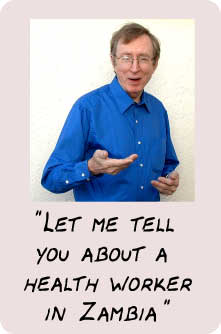|
|
Katalina Groh, Larry Prusak: Some of the world's leading thinkers |
| Storytelling to ignite change: Steve Denning |
 |
The
Zambia story
And then I stumbled on something
else. I would be talking about the future of the World Bank, how the future
was going to be different. But how? What would the future look like. “Well,”
I said, “the future is going to look like today. Let me tell you about
something that happened just a few months ago.”
“In June 1995, a health worker in Kamana, Zambia logged on to the website for the Center for Disease Control in Atlanta, Georgia, and got the answer to a question on how to treat malaria. |
Now this was June 1995, not June 2015.And that did start to resonate. That started to connect with managers. And in fact, it was only later that those managers were able to get to the president of the organization. And in October 1996, at the Annual Meeting of the World Bank, in front of 170 finance ministers, he announced that we were going to do this thing. We are going to be a knowledge sharing organization, from top to bottom. We are going to become “the knowledge bank”. Let’s make it happen. Well, that was not the end of the war. That was just the beginning, because the people who had sent me to Siberia suddenly realized, “The man from Siberia is back! And worse than that, he has this lunatic vision of turning us into a knowledge organization. And he’s somehow co-opted the president and a big slice of the senior management. This is bad news!” In effect, they were thinking that this was their worst-case scenario. And that’s when they started using real bullets, instead of rubber bullets in the process. So in fact, over the next couple of years, we had major struggles, confrontations, and battles at the upper level of the organization as to what this thing called “knowledge management” was, and how we were going to go about implementing it. |
| Books and videos on storytelling *** In Good Company : How Social Capital Makes Organizations Work by Don Cohen, Laurence Prusak (February 2001) Harvard Business School Press *** The Social Life of Information, by John Seely Brown, Paul Duguid (February 2000) Harvard Business School Press *** The Springboard : How Storytelling Ignites Action in Knowledge-Era Organizations by Stephen Denning (October 2000) Butterworth-Heinemann *** The Art of Possibility, a video with Ben and Ros Zander : Groh Publications (February 2001) |
| The views expressed on this website are those of the authors, and not necessarily those of any person or organization |
| Site optimized in 800x600: webmaster CR WEB CONSULTING |
|
|
|
|